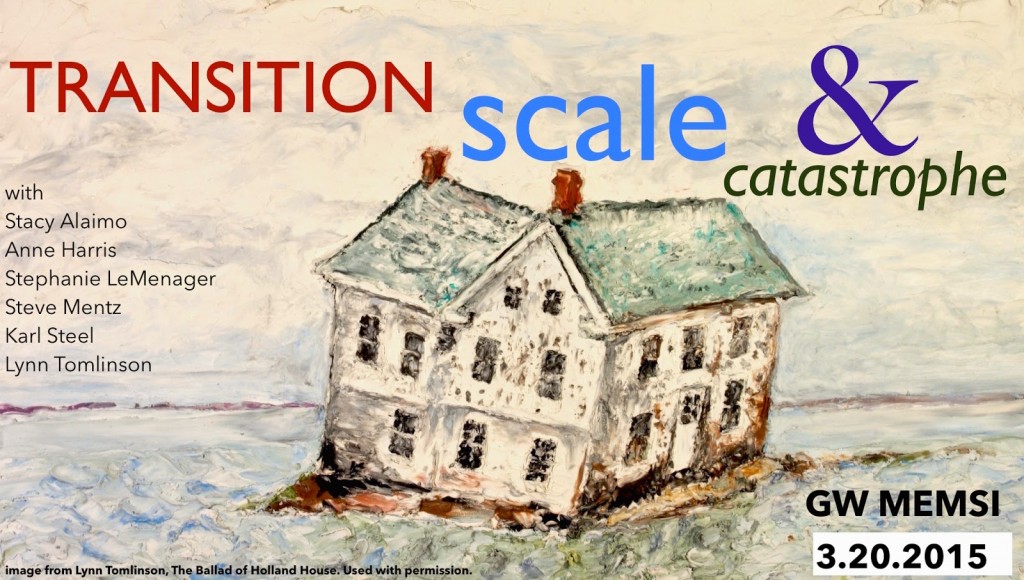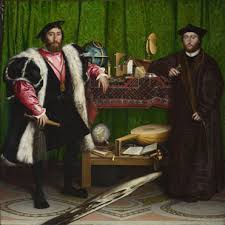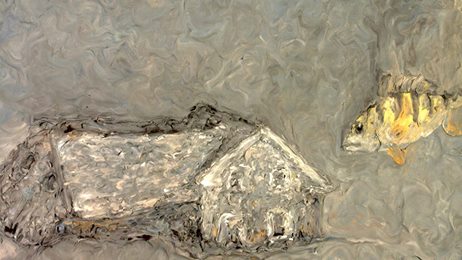 The walls didn’t fall. No flood, nor fire. The AV worked smoothly for everyone, and we even had time to luxuriate twice in Lynn Tomlinson’s gorgeous animated short film, The Ballad of Holland Island House. The bar did run out of dark rum, but by that time of night it was hard to call that a catastrophe.
The walls didn’t fall. No flood, nor fire. The AV worked smoothly for everyone, and we even had time to luxuriate twice in Lynn Tomlinson’s gorgeous animated short film, The Ballad of Holland Island House. The bar did run out of dark rum, but by that time of night it was hard to call that a catastrophe.
So what about last Friday’s symposium makes me feel stretched, exhausted, exhilarated but also vulnerable like an oyster without a shell?
In the middle of my talk I quoted Primo Levi on almost but not quite getting right to the heart of the matter, unlocking impossible questions — what are transition, scale, and catastrophe, really? — with no working tools other than words:
Perhaps, despite the wan translation and the pedestrian, rushed commentary, he has received the message, he has felt that it has to do with him, that it has to do with all of us who toil, and with we two in particular, who dare to reason of these things with the poles for soup on our shoulders (114).
His story of Dante and the whirlpool ends the same place as Lynn’s film —
And over our heads the hollow seas closed up (114).
We went there, but not to stay.
It’s hard to reassemble it all now, the “fierce joy” and collective willingness to play and imagine together. I remember some stray lines, rushed into coherence with a borrowed pen. I’ll stick them here like the petroleum-based clay Lynn used to build her animated house: shapes brought together into structure. A series of alternatives to the catastrophic turns that fell to the ground outside as over-large flakes of wet, late-season snow:
Karl Steel: “as optimistically as possible” “post-agentic optimism” (the latter is my phrase but Karl’s insight)
Stephanie LeManager: “an archive of sensory knowledge” “calling out witnesses” “weathering” (I wanted to ask more about the last term)
Lynn Tomlinson: “animate art” “jellyfish feel nostalgia for the age of humans”
Anne Harris: “every work of art is a remembered ecological crisis”
Stacy Alaimo: “thinking the Anthropocene at sea”
Me: “Something always washes up on the beach”
Those words don’t get it. Not quite. Lynn’s film comes closer, from its seagull opening to the flash of the yellow perch entering the flooded house near the end: finding home in a post-catastrophic world.
These things depend on so much that I can’t write down: on gesture, tone, community, a shared willingness to imagine. Oysters are allegories, and also exposed asymmetrical flesh, salt and patient. We all depended on Jeffrey Cohen‘s ring-master timing, bringing us forward, two by two. On the generosity of the audience. On asking ourselves to change in response to others.
The running gag during the lead-up to the symposium was that we were courting Catastrophe: that was the subject line of weeks of emails. Catastrophe is coming to DC! But for me the best things about this too-soon-over event weren’t the sudden turns of insight or brilliance, though those will linger and inform my thinking for days and years to come. Best of all were the unexpected transitions, the “anamorphic breaks” laid bare by Anne’s brilliant discussion of The Ambassadors, the possibility that an entire other thing might be there, waiting for us, visible if we only allow our eyes to turn, just so, a little more, close one eye to focus: there it is!
What we glimpsed wasn’t Holbein’s allegorical skull. Something else. Something better?
Such a pleasure to gather at GW MEMSI to reason of these things! 

Interested in your term post-agentic optimism, and more specifically, the idea of post-agency. Does post-agency emerge from the realization that our agency isn’t unique or special? Agency is in fact a universal trait, so we can no longer distinguish ourselves from “everything else.” Or is it something entirely different altogether?
It’s really building of Karl Steel’s further thinking through oysters, which he started at Oceanic New York. His point is both that we can’t distinguish ourselves from everything else, which I think of as a basic OOO-and-friends belief, but also that what we share with almost all other forms, living & non-living, is vulnerability and weakness: we are (mostly) oysters, which means our agency amounts to pretty little. It’s a fascinating project that’s been unfurling across 3 or 4 talks now, some of which I’ve heard and others read about on In the Middle, the group blog Karl is part of. He’s also got a piece on “bare life” coming out next fall in *Elemental Ecocriticism,” a collection volume from Minnesota that also features work by Cary Wolfe, Jeffrey Cohen, Stacy Alaimo, and me. I’m sure you’ll run across it in Houston next year!